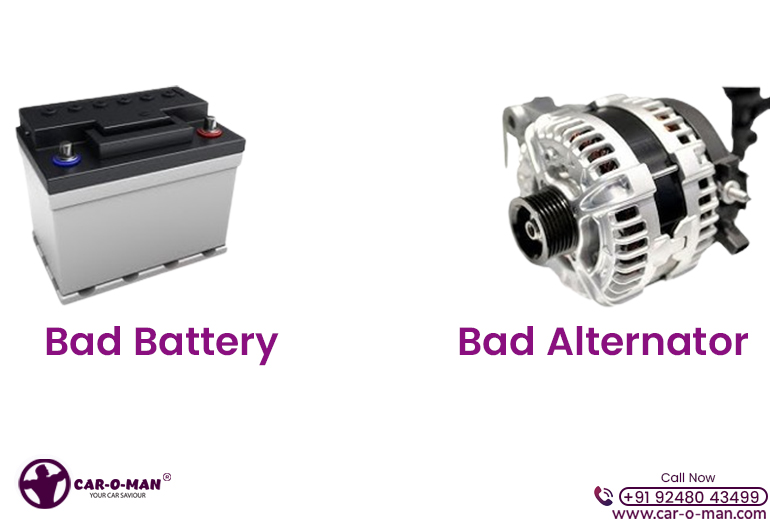If your car won’t start, you might wonder if it’s the alternator or the battery causing the trouble. Understanding the differences between a bad alternator and a bad battery is crucial for proper diagnosis, whether you’re heading to a car service station or considering paint protection film to keep your vehicle in top shape.
Let’s explore the distinct symptoms and signs so you can pinpoint the issue and get back on the road with confidence. Whether it’s for routine maintenance or car denting and painting, knowing the source of the problem is essential.
Symptoms of a Bad Alternator
Experiencing dimming headlights while driving is a common symptom of a bad alternator. When your vehicle’s alternator starts failing, it struggles to provide a consistent flow of power to the electrical components, causing the headlights to flicker or dim unexpectedly. You might also notice other signs, like dashboard warning lights coming on, strange smells like burning rubber, or difficulty starting your car.
Pay attention to any unusual noises, such as grinding or whining, as they could indicate bearing wear within the alternator. If left unaddressed, a faulty alternator can lead to a dead battery and eventually leave you stranded, prompting a visit to car service or car detailing services for further inspection.
Regular maintenance and prompt replacement of a failing alternator can save you from unexpected breakdowns and costly car denting and painting repairs.
Signs of a Failing Battery
When your vehicle’s alternator starts failing, you may notice signs of a failing battery as well. One common sign is difficulty starting your car, where the engine cranks slowly or struggles to turn over. Diminished power to electrical components like lights and radio, even when the engine is running, can indicate a battery issue.
Another clue is if your battery warning light on the dashboard illuminates. A sulfurous or rotten egg smell near the battery could signal a leak or damage. Additionally, visible corrosion on the battery terminals suggests a problem.
Monitoring these signs can help you differentiate between a bad alternator and a failing battery, ensuring timely maintenance to keep your vehicle running smoothly and avoiding potential visits to car detailing services for unforeseen issues.
Diagnostic Testing Variances
To accurately differentiate between a bad alternator and a bad battery, regularly conduct diagnostic testing to identify any variances in performance. When testing, focus on the voltage levels of the battery and the charging system. A voltmeter can help measure the battery’s voltage, which should ideally be around 12.6 volts when fully charged. Start the vehicle and check if the voltage increases to around 13.7 to 14.7 volts; this indicates the alternator is functioning correctly.
If the voltage remains around 12.6 volts even when the engine is running, it may suggest an issue with the alternator. By comparing these voltage readings, you can pinpoint whether the problem lies with the alternator or the battery. This diagnostic approach can help you decide if you need to head to a car service station or seek other specific services like paint protection film installation.
Impact on Electrical Components
Check how a bad alternator or a bad battery can affect your vehicle’s electrical components. When your alternator malfunctions, the electrical components in your car may experience erratic behavior due to fluctuating power supply. Dimming headlights, flickering dashboard lights, or issues with power windows can indicate an alternator problem.
On the other hand, a failing battery can cause similar symptoms but usually leads to a complete loss of power over time. This can result in difficulty starting your vehicle, sporadic electrical failures, or even stalling while driving. To prevent further damage to your electrical system, it’s crucial to address these issues promptly by diagnosing whether the problem lies with the alternator or the battery, possibly saving you from additional trips to car service stations.
Repair and Maintenance Considerations
Addressing issues with a bad alternator or a bad battery requires timely repair and maintenance considerations to ensure the longevity of your vehicle’s electrical system. When dealing with a faulty alternator, it’s crucial to inspect the drive belt, wiring connections, and voltage output. Replacing a worn-out alternator promptly can prevent further damage to the battery and other electrical components.
On the other hand, a malfunctioning battery may necessitate testing the charging system, checking for parasitic draws, and ensuring proper electrolyte levels. Regularly servicing the alternator and battery, such as cleaning terminals, can enhance their performance and extend their lifespan. Ignoring these maintenance tasks can lead to costly repairs and inconvenient breakdowns, so staying proactive is key to preserving your vehicle’s electrical system. Whether you need routine car service or specialized care like car denting and painting, addressing these issues promptly can save you time and money in the long run.


